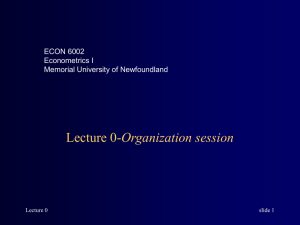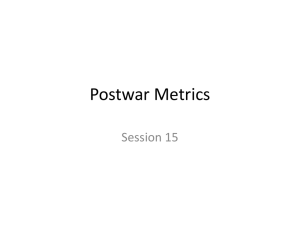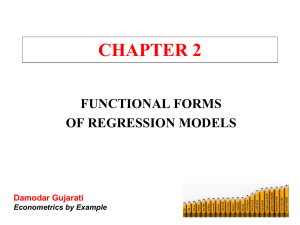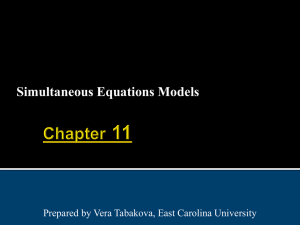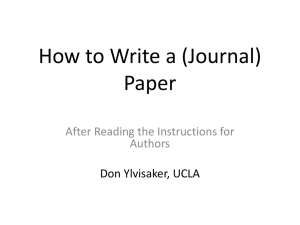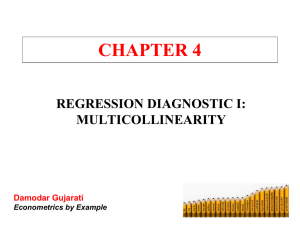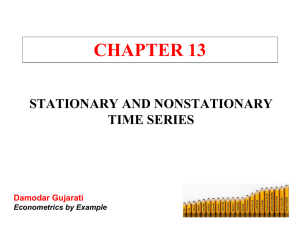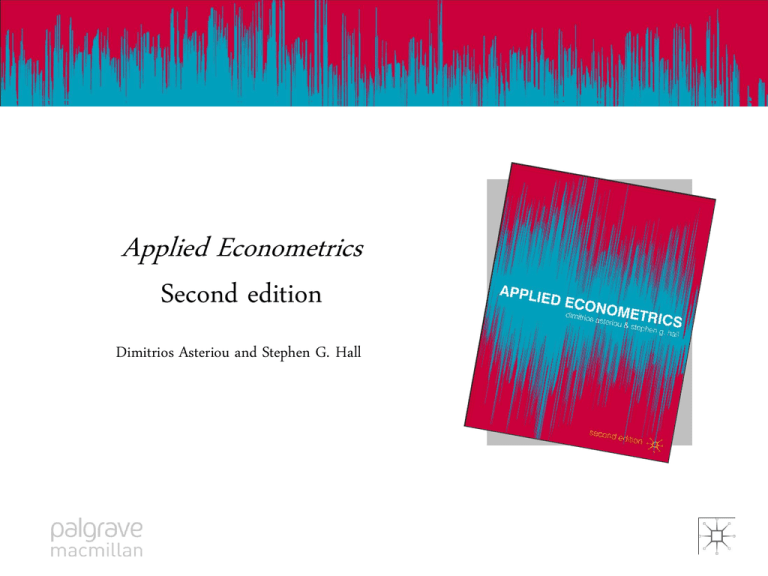
Applied Econometrics
Applied Econometrics
Second edition
Dimitrios Asteriou and Stephen G. Hall
Applied Econometrics
MISSPECIFICATION
1. Ommiting Influential or Including NonInfluential Explanatory Variables
2. Various Functional Forms
3. Measurement Errors
4. Tests for Mispecification
5. Approaches in Choosing an Appropriate Model
Applied Econometrics
Learning Objectives
1. Understand the various forms of possible misspecification in the
CLRM.
2. Appreciate the importance and learn the consequences of omitting
influential variables in the CLRM.
3. Distinguish among the wide range of functional forms and understand
the meaning and interpretation of their coefficients.
4. Understand the importance of measurement errors in the data.
5. Perform misspecification tests using econometric software.
6. Understand the meaning of nested and non-nested models.
7. Be familiar with the concept of data mining and choose an appropriate
econometric model.
Applied Econometrics
Omitting Influential Variables
Omitting influential variables from a regression
model causes these variables to become part of
the error term. Therefore one or more of the
assumptions of the CLRM will be violated.
Consider the population regression function:
Y=β1+β2X2+ β3X3+u
where β2≠0 and β3 ≠ 0, and assume this as the
correct.
Applied Econometrics
Omitting Influential Variables
However, we estimate the following
Y=β1+β2X2+u
where X3 is wrongfully omitted.
Then, the error term of this equation is:
u= β3X3+e
It is clear that the assumption that the error term has
a zero mean is now violated:
E(u)=E(β3X3+e)=E(β3X3)+E(e)= E(β3X3) ≠0
Applied Econometrics
Omitting Influential Variables
Furthermore, if the excluded variable X3 happens
to be correlated with X2 then the error term is
no longer independent of X2.
This results to estimators of β2 and β3 to be
biased and inconsistent.
This is called omitted variable bias.
Applied Econometrics
Including Non-Influential Variables
This is the opposite case. The correct model is:
Y=β1+β2X2+u
and we estimated:
Y=β1+β2X2+ β3X3+e
where X3 is wrongly included in the model.
Applied Econometrics
Including Non-Influential Variables
Since X3 does not belong to the correct model, its
population coefficient should be equal to zero
(i.e. β3=0).
If β3=0 then none of the CLRM assumptions is
violated and OLS estimators are both unbiased
and consistent.
However, it is unlikely that they are efficient.
If X2 is correlated with X3 then an additional
unnecessary element of multicollinearity will be
introduced.
Applied Econometrics
Omission and Inclusion at the same time
In this case the correct model is:
Y=β1+β2X2+ β3X3+v
and we estimate:
Y=β1+β2X2+ β4X4+w
It should be easy now to understand the problems
that this double mistake causes.
Applied Econometrics
The Plug in Solution
Sometimes it is possible to face omitted variable
bias because a key variable that affects Y is
not available.
For example consider a model where the
monthly salary of an individual is associated
with
• Whether or not he/she is male/female.
• Years he/she has spent in education
Applied Econometrics
The Plug in Solution
Both of these factors can be quantified and
included in the model.
However, if we also assume that the salary level
can be affected by the socio-economic
environment in which each person was brought
up, then this is hard to be measured in order to
be included in the model:
(salary)= β1+β2(sex)+β3(educ)
+β3(background)+u
Applied Econometrics
The Plug in Solution
Not including the background variable in the
model leads to biased estimates of β1 and β2.
Our major interest, however, is to get appropriate
estimates for those two coefficients (i.e. we do
not care that much for β3 because we will never
get the appropriate coefficient for that).
A way to resolve that, is to include an alternative
proxy variable for the omitted variable.
Applied Econometrics
The Plug in Solution
For this example what we can use is family
income. Family income is not of course
exactly what we mean with background
but it is definitely a variable that is
highly correlated with that.
Applied Econometrics
The Plug in Solution
To illustrate this consider the model:
Y=β1+β2X2+ β3X3+β4X*4+u
where X2 and X3 are observed, X*4 is unobserved.
We know though that
X*4=δ1+δ2X4+e
Where an error term e should be included because there are not
exactly the same and δ1 is also included in order to allow
them to be measured in a different scale. We need variables
that are positively correlated (i.e. δ2>0)
Applied Econometrics
The Plug in Solution
So we estimate:
Y=β1+β2X2+ β3X3+β4(δ1+δ2X4+e)+u
= (β1+ β4δ1)+β2X2+ β3X3+β4δ2X4+(β4e+u)
= a1
+ β2X2+ β3X3+ a4X4+
w
By estimating this model we do not get unbiased estimates
for β1 and β4, but we get unbiased estimators for a1, β2, β3
and a4.
Applied Econometrics
Various Functional Forms
•
•
•
•
•
•
•
Linear
Linear-Log
Reciprocal
Quadratic
Interaction
Log-Linear
Double Log
Y=β1+β2X2
Y=β1+β2lnX2
Y=β1+β2 (1/X2)
Y=β1+β2X2 +β3X22
Y=β1+β2X2 +β3X2Z
lnY=β1+β2X2
lnY=β1+β2lnX2
Applied Econometrics
The Box-Cox Transformation
The choice of functional form plays important
role; thus, we need a formal test of comparing
alternative models (functional forms).
If we have the same dependent variable things
are easy: estimate both models and choose the
one with the higher R2.
However, if the dependent variables are different
an immediate comparison is impossible.
Applied Econometrics
The Box-Cox Transformation
Assume we have those two models:
Y=β1+β2X2
and lnY=β1+β2lnX2
In such cases we need to scale the Y variable in
such a way that we will be able to compare the
two models.
The procedure that does that is called the BoxCox Transformation.
Applied Econometrics
The Box-Cox Transformation
Step 1: Obtain the geometric mean of the sample Y values.
Y’=(Y1Y2Y3…Yn)1/n=exp[(1/n)ΣlnY)
Step 2: Transform the sample Y values by dividing each of them by
Y’ obtained from step 1 to get:
Y*=Yi/Y’
Step 3: Estimate both models with Y* as the dependent variable.
The equation with the lower RSS should be preferred.
Step 4: If we want to check whether it is significantly better
calculate (1/2 n)ln(RSS2/RSS1) and check with the chi-square
distribution. RSS2 is the one with the lower.
Applied Econometrics
Measurement Errors
Sometimes the data are not measured appropriately.
We can have measurement errors either in the
dependent variable or in the explanatory variables or
both.
If it is in the dependent then we have larger variances
of the OLS coefficients. Unavoidable.
If it is in the explanatory variables, we have biased and
inconsistent estimators. Totally wrong results.
Applied Econometrics
Tests for Misspecification
We have the following tests:
• Test for Normality of the residuals
• The Ramsey RESET test
• Tests for Non-Nested Models
Applied Econometrics
Normality of Residuals
Step 1: Calculate the Jarque-Berra (JB) Statistic
(given in Eviews)
Step 2: Find the chi-square critical value from
the corresponding tables.
Step 3: If JB>chi-square critical reject the null
hypothesis of normality.
Applied Econometrics
The Ramsey Reset Test
Step 1: Estimate the model that we think is correct and
obtain the fitted values of Y, call them Y’.
Step 2: Estimate the model of step 1 again, this time
including Y’2 and Y’3 as additional explanatory
variables.
Step 3: The model in step 1 is the restricted model and the
model in step 2 is the unrestricted model. Calculate the
F-statistic for these two models.
Step 4: Compare the F-statistical with the F-critical and
conclude (if F-stat>F-crit we reject the null of correct
specification.
Applied Econometrics
Tests for Non-Nested Models
If we want to test models which are not nested then we
can not use the F-statistic approach.
Non-nested are the models in which neither equation
is a special case of the other, in other words we
don’t have restricted and unrestricted models.
Suppose for example that we have the following:
Y=β1+β2X2 +β3X3+u
(1)
Y=β1+β2lnX2 +β3lnX3+u
(2)
Applied Econometrics
Tests for Non-Nested Models
One approach (Mizon and Richard) suggests the
estimation of a comprehensive model of the
form:
Y= δ1+ δ2X2 + δ3X3+ δ4lnX2 +δ5lnX3+e
and then to apply an F-test for significance of δ4
and δ5 having as restricted model equation (1).
Applied Econometrics
Tests for Non-Nested Models
A second approach (Davidson and McKinnon)
suggests that if model (1) is true then the fitted
values of (2) should be insignificant in (1) and
vice versa.
So they suggest the estimation of
Y= β1+ β2X2 +β3X3+δY*+e
where Y* is the fitted values of model (2). A
simple t-test of the coefficient of Y* can
conclude.
Applied Econometrics
Choosing the Appropriate Model
There are two major approaches
• The traditional view: Average Economic
Regressions (AER)
• The Hendry’s General to Specific Approach
Applied Econometrics
Choosing the Appropriate Model
• The AER essentially starts with a simple model
and then ‘builds up’ the model as the situation
demands. It is also called simple to specific.
• Two disadvantages:
(a) Suffers from data mining. Only the final model is
presented by the researcher.
(b) The alterations to the original model are carried
out in an arbitrary manner based on the beliefs of
the researcher.
Applied Econometrics
Choosing the Appropriate Model
The Hendry approach starts with a general model that contains
– nested within it as special cases – other simpler models
and then with appropriate tests to narrow down the model to
simpler ones.
The model should be:
(a) Data admissible,
(b) Consistent with the theory
(c) Use regressors that are not correlated with the error term
(d) Exhibit parameter constancy
(e) Exhibit data coherency
(f) Encompasing, meaning to include all possible rival models



